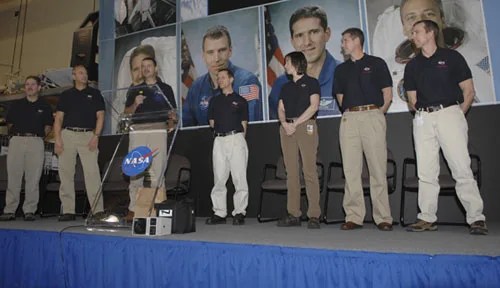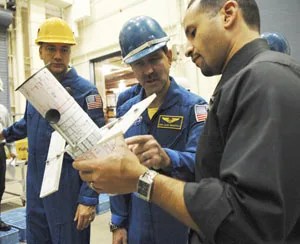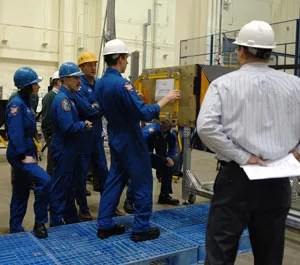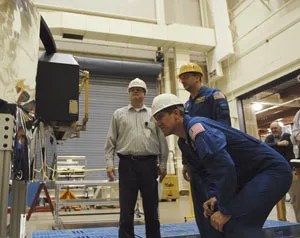4 min read
Seven NASA astronauts, dressed in their famous blue flight suits, arrived at Goddard Space Flight Center in Greenbelt, Md., Feb. 12 for three days of crew familiarization meetings. They are here to begin their official orientation and training for what will be the last shuttle servicing mission to the Hubble Space Telescope in late 2008.
Image above:
Commander Scott "Scooter" Altman introduces the Servicing Mission 4 crew to the Hubble Space Telescope team.
Click image to enlarge.
Credit: NASA
The crew spent their mornings in training sessions, and afternoons inside the world’s largest Class 10,000 cleanroom at Goddard. During their three-day visit, the astronauts received extensive briefings about Hubble operations, Goddard facilities and hardware, and the mission's five scheduled spacewalks. During the mission, astronauts will install two new science instruments, as well as perform essential upgrades to the observatory.
"While Johnson Space Center provides underwater training for the astronauts in its Neutral Buoyancy Lab, Goddard offers them hands-on experience using high fidelity mock-ups of Hubble and the specialty tools required for the tasks that lie ahead," said Preston Burch, associate director and program manager for Hubble at Goddard. "Together, we help ensure a flawless servicing mission."
The crew chosen for this servicing mission includes commander and veteran astronaut Scott Altman, shuttle pilot Navy Reserve Capt. Gregory C. Johnson, veteran spacewalkers John Grunsfeld and Mike Massimino, and first-time space fliers Andrew Feustel, Air Force Col. Michael Good, and flight engineer and robotic arm operator K. Megan McArthur.
New Instruments Mean New Promise of Unknown Science Discoveries
During the servicing mission, Hubble will be outfitted with two new science instruments – the Cosmic Origins Spectrograph (COS) and Wide Field Camera 3 (WFC3).
Image left:
ExtraVehicular Activity Officer Tomas Gonzalez-Torres explains Hubble nomenclature to vetran HST Astronauts John Grunsfeld and Mike Massimino.
Click image to enlarge.
Credit: NASA
The COS will be the most sensitive ultraviolet spectrograph ever flown on Hubble, providing new capabilities that will take the telescope into exciting, uncharted space. Its primary science objective will be to measure the structure and composition of the ordinary matter that is concentrated in what scientists call the ‘cosmic web’ – long, narrow filaments of galaxies and intergalactic gas, separated by huge voids. Astronauts will install the COS in the instrument bay currently outfitted by ‘COSTAR’ – the set of corrective mirrors on deployable arms which provided corrected light beams to the first generation of Hubble axial instruments.
The WFC3 is a new camera sensitive across a wide range of wavelengths, including near infrared, visible, and ultraviolet light. The primary goal of this instrument is to study a diverse range of objects and phenomena, from young and extremely distant galaxies, to much more nearby stellar systems, to objects in our very own solar system. Astronauts will install the WFC3 in the instrument bay currently holding the Wide Field Planetary Camera 2 (WFPC2).
Hubble to Get Some Necessary Upgrades
Image right:
Astronaut Andrew "Drew" Feustel inspects the Fine Guidance Sensor mockup interfaces.
Click image to enlarge.
Credit: NASA
In addition to new science instruments, astronauts will install new gyroscopes, new batteries, new outer blanket layers (sheets of aluminum that will lower the temperature in critical electronics), and a refurbished Fine Guidance Sensor that helps control the telescope's pointing system.
Astronauts also will attempt a complex, on-orbit repair of the Space Telescope Imaging Spectrograph, or STIS, which was installed in 1997, and stopped working in 2004. Astronomers used the STIS for high resolution studies in visible and ultraviolet light of both nearby star systems and distant galaxies, which provide clues about the motions and chemical makeup of stars, planetary atmospheres, and other galaxies.
Finally, astronauts will install a Soft Capture Mechanism to Hubble’s aft bulkhead. This circular device has structures and targets that will allow a de-orbit vehicle to more easily capture and guide the telescope to a safe, controlled re-entry at the end of its mission life.
The Journey Continues
Image left:
Astronauts Mike Good and Mike Massimino inspect the Fine Guidance Sensor trainer.
Click image to enlarge.
Credit: NASA
Please check back periodically for more articles about this exciting journey back to Hubble, one that will most likely rewrite textbooks for years to come.
Susan Hendrix
Goddard Space Flight Center











